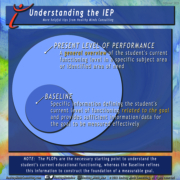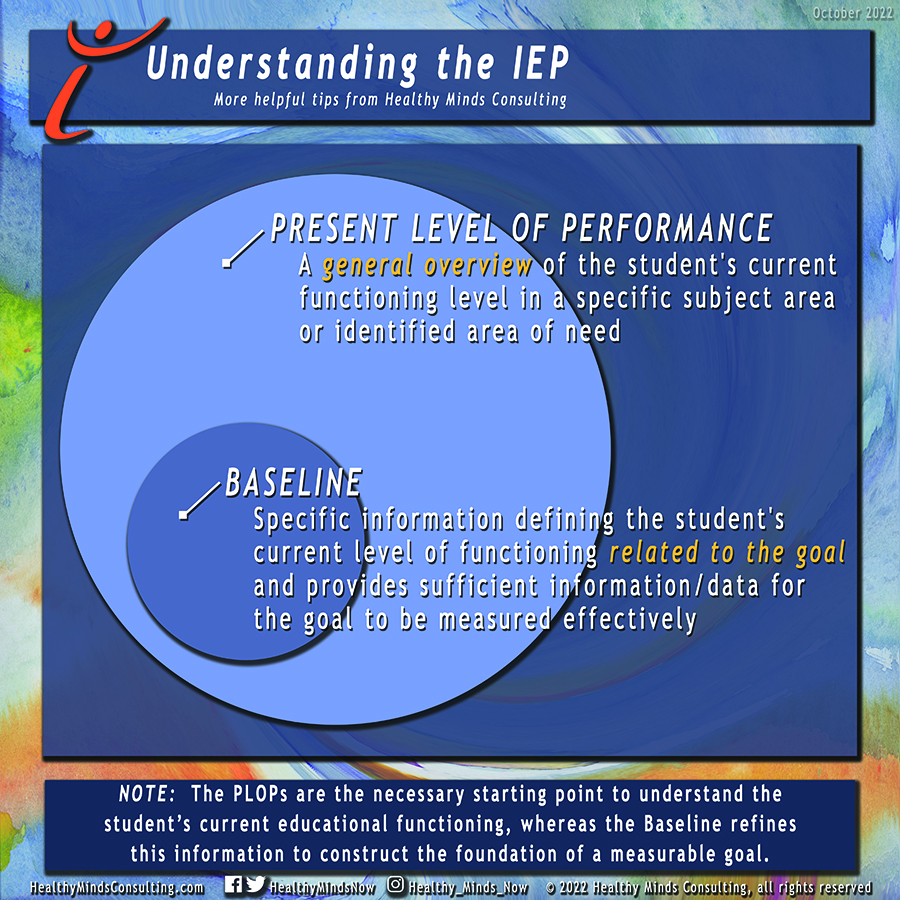Baselines vs. Present Levels: Is there a Difference?

See this image full size below the article.
Individualized Education Programs (IEP) are both the foundation and culmination of team effort to address the needs of a student with a disability. There are many components to an IEP and seemingly as many acronyms. Many terms are used frequently but not necessarily defined meticulously and therefore some inadvertently become misused. Baseline and Present Level of Performance, for example, are often referred to interchangeably. This is understandable, as they are often closely related. There are, however, important distinctions between the two terms; they are not actually synonymous.

Present Levels of Performance, often abbreviated as PLOP (or similar acronyms), are descriptions of how the student is currently functioning, often including notation of essential skill levels acquired in each area of need. It is usually most helpful when this information is specific and is supported by data that has been collected. Yet the PLOP is also designed to contain a general overview of the student’s progress in each identified area of need and a description of how the student’s disability affects their involvement and progress in the general education curriculum1. This information is utilized by the IEP team to better understand where the student is presently and to make informed decisions on where the team wants them to be one year later.
Baselines are needed to have a solid, data-driven foundation for a specific goal. Without an accurate baseline, there is no known starting point for the goal which makes it impossible to ensure the goal is appropriately challenging for the student. For example, if we want to write a goal that a student will be able to accurately solve problems using the Pythagorean theorem, it is helpful to know whether the student is able to identify a triangle and a square, understands exponents and square roots, and has a functional knowledge of algebraic equations. Knowing to what degree they understand each of these items allows the IEP team to evaluate whether the goal that is being written is appropriately challenging and whether it will likely be able to be met once appropriate supports and services are in place.
 The PLOPs are extremely valuable for informing the IEP team of the student’s current functioning level in a particular area of need impacted by their disability. Once the team has this information, they can collaborate on a goal that will facilitate the student’s growth in each unique area of need. Yet in order to create a satisfactory goal that both meets legal requirements1 and supports the student’s educational development, we need the baseline and the goal to be in the same language. For example, if the PLOP describes the student’s abilities by noting the scores from recent assessments (such as receiving a score of 66 on the Woodcock-Johnson Test of Achievement in the area of Passage Comprehension) but the goal is written in a way that asks the student to achieve at a rate of 80% accuracy in 3 out of 4 trials, there is no way to accurately measure whether the student made any progress on their goal. We need the additional data that shows what percentage of accuracy the student is achieving currently, and in how many trials, with the exact same wording as the goal that is being developed. Knowing whether the student is currently at 0% accuracy in 4 out of 4 trials, or 78% accuracy in 2 out of 4 trials, will greatly impact the team’s decision-making on the proposed achievement rate of the goal itself. Alternatively, the team may decide to change the goal so that it is measured by a reassessment with the Woodcock Johnson Test of Achievement again and incorporate the score (i.e. scoring 86 on the Passage Comprehension portion of the Woodcock Johnson) that they expect the student will be able to achieve after appropriate interventions have been implemented.
The PLOPs are extremely valuable for informing the IEP team of the student’s current functioning level in a particular area of need impacted by their disability. Once the team has this information, they can collaborate on a goal that will facilitate the student’s growth in each unique area of need. Yet in order to create a satisfactory goal that both meets legal requirements1 and supports the student’s educational development, we need the baseline and the goal to be in the same language. For example, if the PLOP describes the student’s abilities by noting the scores from recent assessments (such as receiving a score of 66 on the Woodcock-Johnson Test of Achievement in the area of Passage Comprehension) but the goal is written in a way that asks the student to achieve at a rate of 80% accuracy in 3 out of 4 trials, there is no way to accurately measure whether the student made any progress on their goal. We need the additional data that shows what percentage of accuracy the student is achieving currently, and in how many trials, with the exact same wording as the goal that is being developed. Knowing whether the student is currently at 0% accuracy in 4 out of 4 trials, or 78% accuracy in 2 out of 4 trials, will greatly impact the team’s decision-making on the proposed achievement rate of the goal itself. Alternatively, the team may decide to change the goal so that it is measured by a reassessment with the Woodcock Johnson Test of Achievement again and incorporate the score (i.e. scoring 86 on the Passage Comprehension portion of the Woodcock Johnson) that they expect the student will be able to achieve after appropriate interventions have been implemented.
This dance between refining the PLOP into a data-informed baseline by evaluating both the goal itself and ensuring there is a consistent understanding of the starting point, is essential for creating valuable goals that can provide accurate and specific data to inform the IEP team on the student’s progress. To learn more about how to write and evaluate quality goals, check out our training Beyond SMART Goals: How to MASTER IEP Goals.
When looking at the big picture, the PLOPs are the necessary starting point to understand the student’s current educational functioning, whereas the Baseline refines this information to construct a measurable, attainable, and appropriately challenging goal. Both are indispensable parts of the IEP process and contribute to the creation of goals that will effectively meet the needs of the student.

 Kelly Rain Collin, Ed.M. is an Educational Consultant and Advocate who specializes in uniting the fields of education and mental health to foster students’ self-esteem and academic success. She is the Founder and Director of Healthy Minds Consulting and provides trainings and consultation to schools, parents, attorneys, advocates, and service providers on IEP goal creation, the unique needs of students with Fetal Alcohol Spectrum Disorders (FASD), how to create IEPs that bolster students’ self-confidence, and other related content.
Kelly Rain Collin, Ed.M. is an Educational Consultant and Advocate who specializes in uniting the fields of education and mental health to foster students’ self-esteem and academic success. She is the Founder and Director of Healthy Minds Consulting and provides trainings and consultation to schools, parents, attorneys, advocates, and service providers on IEP goal creation, the unique needs of students with Fetal Alcohol Spectrum Disorders (FASD), how to create IEPs that bolster students’ self-confidence, and other related content.
*NOTE: Healthy Minds Consulting does not employ attorneys and none of our content should be construed as legal advice.
1Legal requirements include, but are not limited to: 20 U.S.C. §1414(d)
Click here to add your own text



